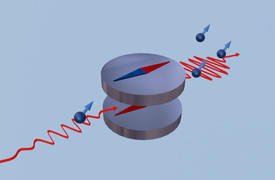

06/29/2020

© 2020 Shigemi Mizukami
A convenient way to amplify wave-like precessions of electron spin in a magnetic material with a sandwich-like structure has been found by AIMR researchers1. This amplification could find use in a new generation of computers inspired by the brain.
Conventional, silicon-based computer technology is rapidly approaching the physical limits of miniaturization. As a result, engineers are searching for alternative computing technologies for the ‘post-silicon era’. One promising technology is neuromorphic computing, which seeks to mimic how the brain processes data.
Precessions of electron spins known as magnons, which can exhibit both particle-like and wave-like behaviors, are attractive candidates for use as information carriers in neuromorphic computers. But because magnons cannot sustain themselves, an energy-efficient, nanoscale way to amplify them is needed before they can be used in circuits.
Previously, Shigemi Mizukami of the AIMR at Tohoku University and co-workers had observed two modes of magnons in a synthetic antiferromagnet — a magnetic material that consists of a non-magnetic layer sandwiched between two ferromagnetic layers, where the magnetizations of the ferromagnetic layers point in opposite directions. They saw a high-frequency optical mode and a low-frequency acoustic mode.
Now, by using a technique they developed that employs ultrafast laser pulses, Mizukami and his colleagues have found that the optical magnon mode amplifies the acoustic mode when they interact (see image). Specifically, they found that the acoustic mode gets a temporary kick from the optical mode when its frequency is roughly half that of the optical mode.
The researchers anticipate that this effect could be used to produce an energy-efficient nanoamplifier of magnons. “This finding is a first and important step towards realizing magnonic computing,” says Mizukami. “In particular, it gives a new perspective for developing nanoscale spintronic elements that will form the building blocks for future neuromorphic computers.”
To gain more insights into the effect, the researchers performed a mathematical analysis of the magnon amplification. To their surprise, they found that the equations describing the phenomenon are the same as those for a child propelling a swing by moving their legs. “The math underpinning this effect is identical to that for a child on a swing,” says Mizukami. “The math is very simple and describes many physical phenomena in nature, but we were surprised to discover that such fundamental physics is inherent in a synthetic antiferromagnet.”
The researchers intend to realize new magnonic computing architectures utilizing this amplification principle in synthetic antiferromagnets.
This research highlight has been approved by the authors of the original article and all information and data contained within has been provided by said authors.